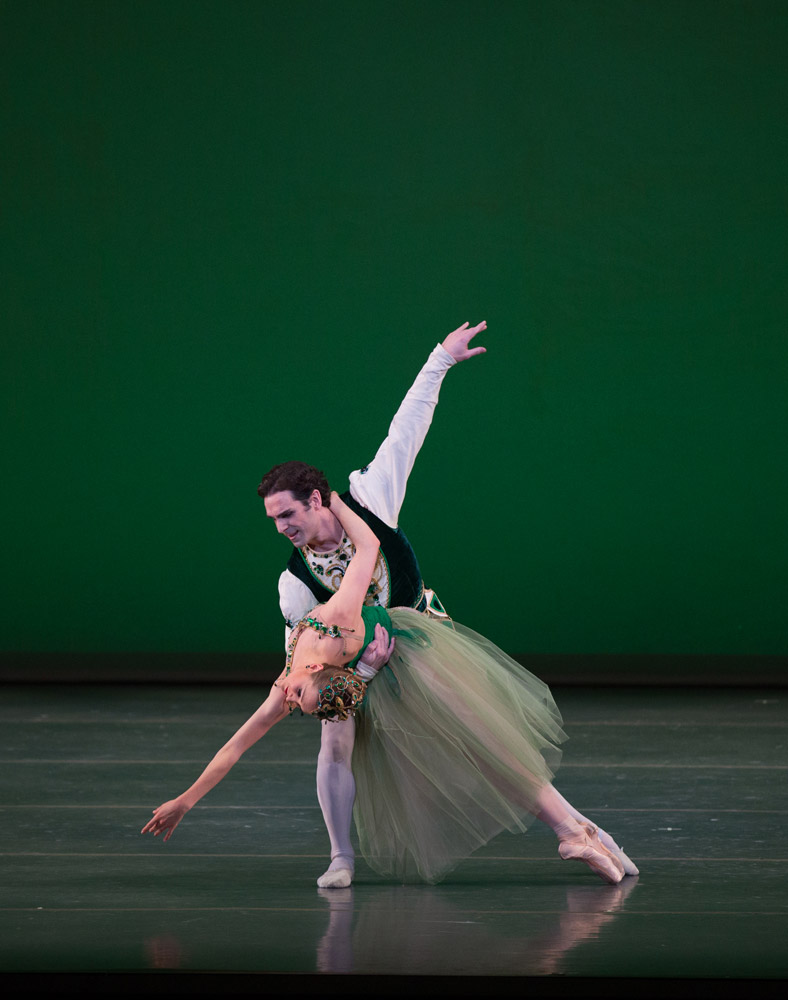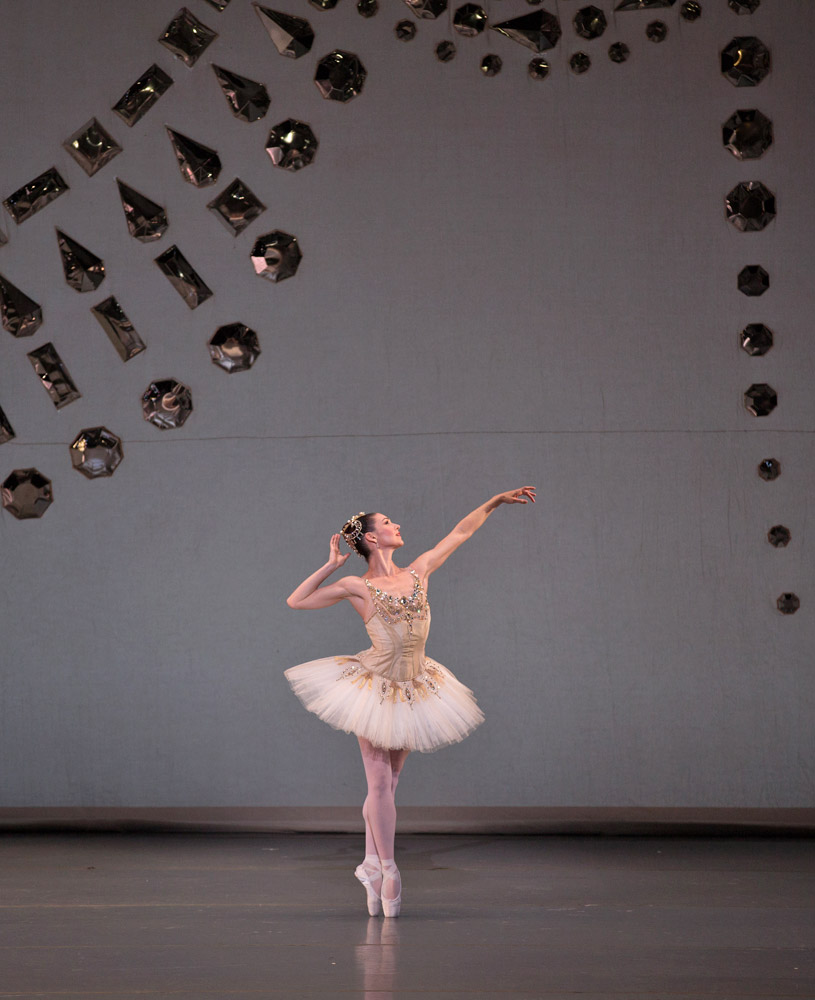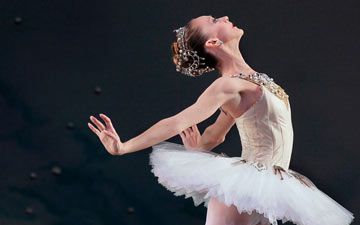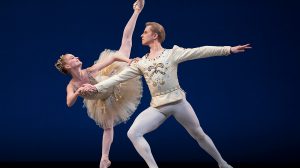
© Rosalie O’Connor. (Click image for larger version)
Boston Ballet
Jewels: Emeralds, Rubies, Diamonds
Boston, Opera House
22 May 2014
www.bostonballet.org
To close its 50th anniversary season Boston Ballet mounted a splendid production of Balanchine’s 1967 masterpiece Jewels. Inspiredby a visit to the New York showrooms of Van Cleef and Arpels the year before, Balanchine conceived the idea of a plotless ballet (the first full-length abstract ballet) built around three gemstones: Emeralds set to incidental music from Faure’s Pelléas et Mélisande and Shylock; Rubies to Stravinsky’s Capriccio for Piano and Orchestra; and Diamonds to Tchaikovsky’s Third Symphony minus its first movement. It’s common knowledge that Emeralds is meant to evoke the French school of ballet, Rubies, the American school of ballet and Diamonds, the Russian school of ballet. All three parts are therefore completely different but united by an architecture so pure and clear it might be a Platonic ideal in the mind of Descartes. And rarely has a ballet so embodied its music as this one does, helping us understand what Balanchine meant in saying that in all good dance we should be able to see the music and hear the dance.

© Rosalie O’Connor. (Click image for larger version)
The mood of Emeralds is that of Andrew Marvel’s “green thought in a green shade”: pensive, perfumed with dreamy melancholy, and restrained. It’s also courtly, full of the etiquette that attended the invention of ballet in Louis XIV’s 17th century France. On opening night, Ashley Ellis and Yuri Yanowsky were the first lead couple, and Ellis, always a lovely dancer with a beautiful line, continued to surprise and delight me with her sparkling personality. At the beginning of her solo when she seems to be admiring her rings, her mime was delicious, and she created just the right mood of wistful yearning. Yanowsky was once a commanding dancer but no longer, and his forced expressions were painful to see.

© Rosalie O’Connor. (Click image for larger version)
The second Emeralds lead couple, Lia Cirio and Llasha Khozashvili, were better matched by far, and Rie Ichikawa, Dalay Parrondo (always a treat) and Issac Akiba performed admirably as the remaining leads. In fact Akiba was the most vital male presence in the piece, performing with energy, precision and great panache. The conclusion in which our three men fall to one knee, an arm raised in final benediction, is one of the most unexpected and thrilling in all of ballet. For a choreographer who believed that “Ballet is woman,” it’s almost shocking that he concludes Emeralds with this magical male moment.

© Rosalie O’Connor. (Click image for larger version)
Rubies, which is often presented alone, is one of the most continuously inventive ballets in the repertory, filled with irresistible, madcap virtuosity. Evoking the spirit of American ballet, it’s sexy, fast, irreverent, playful and angular, with pelvic thrusts and jutting elbows. The men jog like jockeys, the women prance like fillies, and everyone skips rope and stomps their feet. It contains a lot of expressive awkwardness (dancers often balance and pivot on their heels and assume off-balance positions) and combines the bawdy of burlesque, the humor of musical comedy and the esprit of the three-ring circus, all favorite American past-times.

© Rosalie O’Connor. (Click image for larger version
Replacing Whitney Jensen on opening night in the role of the Tall Girl, Dusty Button was excellent, her perfect Balanchine body (long limbs, small head, long neck) ideal for the part. The lead couple, Misa Kuranaga and Jeffrey Cirio, were superb, both fueled by intergalactic energy and dancing their hearts out. My companion thought the company should have had a carriage waiting outside the Opera House to parade Kuranaga and Cirio in triumph through the streets of Boston.

© Rosalie O’Connor. (Click image for larger version
In contrast to the hectic dazzle of Rubies, Diamonds is slow, measured, and stately. And of the three pieces, it’s the one most closely based on traditional classical movement, even repeatedly alluding to Swan Lake and Sleeping Beauty. From beginning to end, it conveys the glamour of 19th century imperial Russian ballet, building to an overwhelming climax as 35 dancers move in complex formations into the majestic, closing chords of the grand finale, perhaps the best of what Lincoln Kirsten called Balanchine’s “applause-machines.”
On opening night, Kathleen Breen Combes was magnificent. (She was equally superb in Rubies the following night.) Each time I see her, I think I’m seeing dancing so good it can’t possibly be improved. Her technique is flawless, her presence charismatic, her musicality brilliant, and her ease and authority peerless. Everything she does has a purpose and clarity that are riveting. She was especially compelling in those echoes of Swan Lake when she appeared as a hunched bird suddenly propelling itself into flight. Alexandro Virelles was her very capable partner.

© Rosalie O’Connor. (Click image for larger version)
Jonathan McPhee conducted the disparate scores with his usual élan, and the company looked great throughout. Jewels is an especially demanding ballet to produce, but the dancers performed it with ease and polish. Unfortunately, the production doesn’t look as good as it should. In Emeralds, the women’s headdresses are ugly and the men’s bejeweled doublets make them look like refugees from a high school production of Ivanhoe. The lime green backdrop, which shows a huge tiara composed of cheap green glass, looks as soiled as a dirty napkin. The backdrop for Diamonds is a gigantic parure made not of faceted, glittering crystals but what appear to be dull tin or tarnished chrome elements. But the choreography, oh my Lord! It’s inexhaustibly inventive and as fresh as the day it was created, and it feels far more contemporary than most of the ballets created in the past ten years. Watched a hundred times, it would still yield surprises.
Congratulations to Boston Ballet for this brilliant conclusion to its 50th anniversary season, and all our best wishes for its bright future.

















You must be logged in to post a comment.